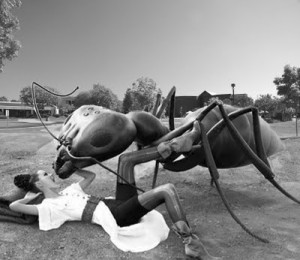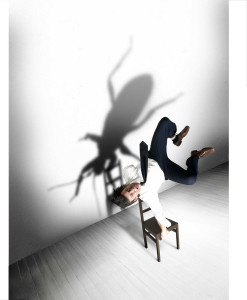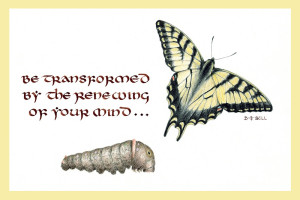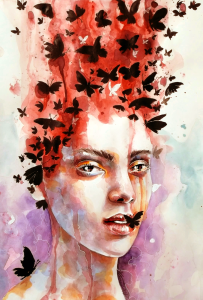 I kill my ANTS! What do I mean by this?
I kill my ANTS! What do I mean by this?
I’m working to SQUASH my negative thinking patterns. More than ever before– I am going to fight them off! OK, I concede there is no way I can exterminate them completely because they are AUTOMATIC. Renowned brain disorder psychiatrist, Dr Amen coined the word ANTS for them, Automatic Negative Thoughts in his book Change Your Brain, Change Your Life. He describes them as “the little voices that pop into your head and tell you you’re not good enough, not thin enough, a rubbish daughter, mother, worker.” A few ANTS, he says, can be managed. But he warns to watch out for ANT-infestations — when hundreds of negative thoughts start to take over. Has this ever happened to you?
It has happened to me. Like when I eat one of those incredible Trader Joe’s dark chocolate peanut butter cups and wow, it blows me away… so I eat one more… then just one more. Then I think, well I’ve blown my low sugar allotment for today so I may as well finish off the bag… I can never do this low sugar diet thing anyway… I just don’t have the discipline or will power or whatever it takes… (more negative thoughts)… no wonder I’m a failure in certain areas of my life, like being blocked in my creative work right now… and on and on…
Here are some examples of typical ANTs (automatic negative thoughts):
“You never listen to me.”
“Just because we had a good year in business doesn’t mean anything.”
“You don’t like me.”
“This situation is not going to work out. I know something bad will happen.”
“You are an arrogant know-it-all.”
“I should have done much better. I’m a failure.”
“Its too late for me.”
“I wish I was creative.”
“It’s your fault.”
These thoughts severely limit our creative powers. The answer, Dr. Amen says, lies in simple ANT-eater techniques that stop the bugs in their tracks. “Your brain is a powerful organ,” he says. “If you see yourself as fat, old, wrinkled or forgetful, you boost production of the stress hormone which affects your health, your weight and your mind… Negative thoughts can make negative things happen.”
 Why should I/we care about creating our own personal ANT eaters? Because we know our NEGATIVE THOUGHTS un-monitored lead to NEGATIVE CHOICES, which lead to NEGATIVE HABITS and our habits determine our CHARACTER, which becomes our DESTINY. Oh no(!), fat, old and uncreative we think… NOT! How do I/we stop this nonsense?! My ants invade my mind like ants at a picnic. They arrive suddenly, are unwanted, uninvited, stinging ugly sticklers that don’t leave unless I intentionally force them out!
Why should I/we care about creating our own personal ANT eaters? Because we know our NEGATIVE THOUGHTS un-monitored lead to NEGATIVE CHOICES, which lead to NEGATIVE HABITS and our habits determine our CHARACTER, which becomes our DESTINY. Oh no(!), fat, old and uncreative we think… NOT! How do I/we stop this nonsense?! My ants invade my mind like ants at a picnic. They arrive suddenly, are unwanted, uninvited, stinging ugly sticklers that don’t leave unless I intentionally force them out!
It helps to understand there are at least nine categories of negative thoughts. There are nine different ways our thoughts lie to us and make situations seem worse than they are, listed below. Our first step is to identify—NAME– the type of ANT, and by doing this we begin to take away its power.
Which of these nine show up most in your thinking?
- “Always/never” thinking: thinking in words like always, never, no one, everyone, every time, everything.
- Focusing on the negative: seeing only the bad in a situation
- Fortune-telling: predicting the worst possible outcome to a situation
- Mind reading: believing that you know what others are thinking, even though they haven’t told you
- Thinking with your feelings: believing negative feelings without ever questioning them
- Guilt beating: thinking in words like should, must, ought, or have to
- Labeling: attaching a negative label to yourself or to someone else
- Personalizing: investing innocuous events with personal meaning
- Blaming: blaming someone else for your own problems — a red ant, it is very poisonous!
I’ll be honest and share that patterns 7 and 8 are ‘stinkin’ thinking’ ANTs for me. I use the 5 A’s of awareness, acceptance, appreciation, action, and adherence (discussed in my newly published book) to squash these suckers. My stinkin’ thoughts must be noticed, captured and accepted as real before I can take action and replace them with more realistic positive thoughts and choices.
 If I don’t deal with my ANTS in real time the result is the 5 D’s—depressed, despair, dissed, de-energized and deflated. I need SOS in real time– stop, observe and shift techniques. If I’ve allowed a genuine infestation to occur, then worse, I become devastated and immobile.
If I don’t deal with my ANTS in real time the result is the 5 D’s—depressed, despair, dissed, de-energized and deflated. I need SOS in real time– stop, observe and shift techniques. If I’ve allowed a genuine infestation to occur, then worse, I become devastated and immobile.
Its no wonder these mind attackers don’t go away– but must be managed. Some truly frightening scientific facts about ants include: they are as old as dinosaurs, have already survived a mass extinction event, have conquered almost the entire globe, their total population make our 7 billion look weak, they can exceed two inches in length (!), they have a hive mind (a killer!) and they actually practice slavery. It is true—they commonly raid neighboring colonies and steal eggs or larvae in a practice known as “dulosis.” Their forcibly acquired young are then either eaten or put to work.
In our never-ending ANT battles, our redemption lies in building our own arsenal of ANT-eater solutions. I will not be captured automatically as a slave to my own ANT’s! I will fight them and kill them—this is my choice!
I invite you to share how you feed your anteaters? Onward and upward brave soldiers—together lets KILL our ANTS, lets revolt together!
Thank you for reading my post. I am an organizational and business consultant living in the mountains of Santa Fe, New Mexico with my husband and dogs. I enjoy hiking and high desert gardening. My core message of everyone is creative resonates with people of all ages and walks of life. I invite all to become the best version of themselves and find true meaning by pursing long term creative quests.






